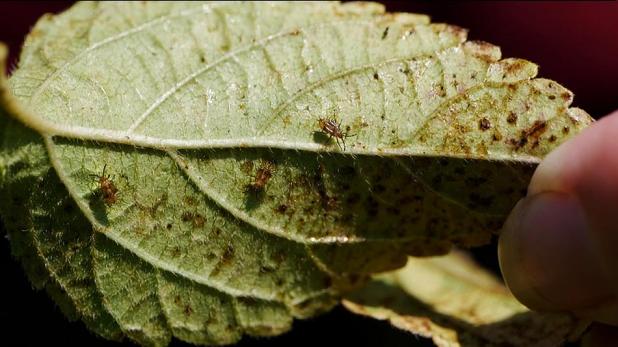
Lace bugs can be found on the underside of leaves.
—LSU AgCenter/Heather Kirk-Ballard
Get It Growing: What’s eating your plants?
Does your lantana have yellowed leaves or brown spots? Is it pale and sickly looking with no flowers? The likely culprit is lace bugs. They are the most common insect found on azaleas, lantana and verbena.
Right now, lace bugs are in full effect as the insect population explodes at temperatures of 90 degrees in the summertime. Otherwise, they generally go unnoticed in the spring leading up to summer when lace bugs go from a small population to an infestation. That’s when the plants begin to manifest the telltale signs.
Although the attack is on the underside of the leaf, damage is first visible on the top side, where leaf surfaces become covered with white, yellow and brown mottling. Heavy infestations cause the leaves to turn yellow, browning the leaf tips and moving inward to the base of the plant before eventually dying and falling off.
These insects are called lace bugs because the adult insects have thin, lacy wings on a rectangular brown-to-black body. They are very small at about 1/8- to ¼-inch long. The immature lace bug is black with small spines and does not have wings.
Several species of lace bugs cause damage to plants, mainly ornamental shrubs and perennials. The adults lay eggs on the underside of the leaf along the midrib where they are secured with a brown, sticky substance that’s easily noticed when the plant is heavily infested. Lace bugs also feed on young flower buds. So if your lantana bloom is reduced or has stopped completely, this is another sign.
Lace bugs prefer plants in the heath family (Ericaceae), which includes both azaleas and rhododendrons, in addition to the verbena family (Verbenaceae), to which lantanas and verbenas belong. They all are some of the best-flowering landscape plants for the Gulf South. They stand up to the heat and can tolerate drought, all while attracting pollinators and luring gorgeous butterflies.
Lantana and verbena perform best in full sun and bloom in several colors. Bandana lantana is Louisiana Super Plant selection that blooms from spring through the fall in Louisiana. Homestead verbena is a prolific bloomer, attracting butterflies and spreading as groundcover along with being used in hanging baskets.
All of these plants typically hold up and survive most pests. However, you may need to intervene if they become infested and affect the vigor of the plants. In addition to lace bugs, these plants can also be attacked by mites, aphids, white flies and mealy bugs. These insects cause their damage by sucking sap from the plant tissue.
The insects then excrete a honeydew that accumulates on the leaves and stems of the rest of the plant. Black fungus, called sooty mold, then feeds and grows on the excrement. Sooty mold is ugly, and it affects plant growth and vigor by reducing photosynthesis.
Spider mites are another pest that along with lace bugs exert the most damage during the hottest, driest time of summer from July through September.
Attack pest problems by scouting plants often and controlling them early. Properly identify the insect pest, and you will be able to control it best. Use control practices that are the most effective against the specific insect and are the least harmful to the environment and to beneficial insects, such as bees and butterflies.
Most insect and mite pests are naturally regulated by beneficial insects, including assassin bugs, immature and adult lady beetles, lacewing larvae, spiders, predaceous mites and various tiny parasitic wasps.
Use cultural control measures first. This includes maintaining healthy plants that are not stressed. Achieve this through weed control, proper lighting, water and nutrient management. In this way, we protect beneficial insects and the environment.
You can also try mechanical control by spraying the underside of leaves with a hard jet of water from a garden hose, dislodging adult bugs and possibly killing the immature ones.
Last resort is chemical control. Insecticidal soap, horticultural oil, neem oil and most chemical insecticides provide good control. Directly spray the underside of the leaves for best coverage. Systemic insecticides with active ingredients such as acephate or Imidacloprid provide the best control and are used as drenches for the roots that are then translocated throughout the plant.
Before using any pesticide, be sure you read and follow the label instructions. Check plants again in two weeks to see if a second treatment is needed. Once the pests are gone, the plant will begin new growth and blooms should return. Make a wise decision on control to help protect the environment and our beneficial insects.
You can also choose lantana cultivars that are considered more resistant to lace bugs such as Weeping White, White Lightning, Weeping Lavender, Imperial Purple, Patriot Rainbow, Denholm Dwarf White, Radiation, Dallas Red and Gold Mound. According to the Center for Urban Agriculture with the University of Georgia cooperative extension, lantanas that are more resistant to lace bug are cultivars of Lantana montevidensis and varieties with smaller leaves.
